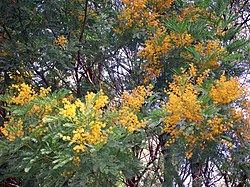| Blay's wattle | |
|---|---|
 | |
| Scientific classification | |
| Kingdom: | Plantae |
| Clade: | Tracheophytes |
| Clade: | Angiosperms |
| Clade: | Eudicots |
| Clade: | Rosids |
| Order: | Fabales |
| Family: | Fabaceae |
| Subfamily: | Caesalpinioideae |
| Clade: | Mimosoid clade |
| Genus: | Acacia |
| Species: | A. blayana |
| Binomial name | |
| Acacia blayana | |
 | |
| Occurrence data from AVH | |
| Synonyms [2] | |
Racosperma blayanum(Tindale & Court) Pedley | |

Acacia blayana, commonly known as Blay's wattle [3] or Brogo wattle, [4] is a species of flowering plant in the family Fabaceae and is endemic to the south-east of New South Wales. It is a tree with dark grey bark, leathery, bipinnate leaves, bright yellow to golden-yellow flowers arranged in spherical heads, and straight or slightly curved leathery pods.
